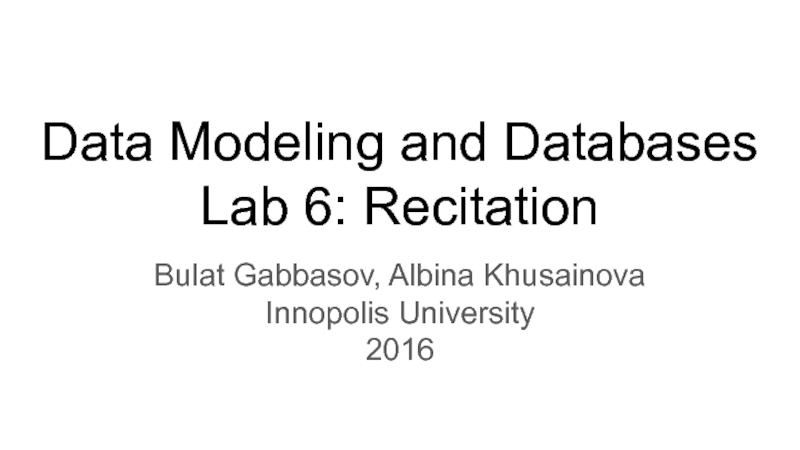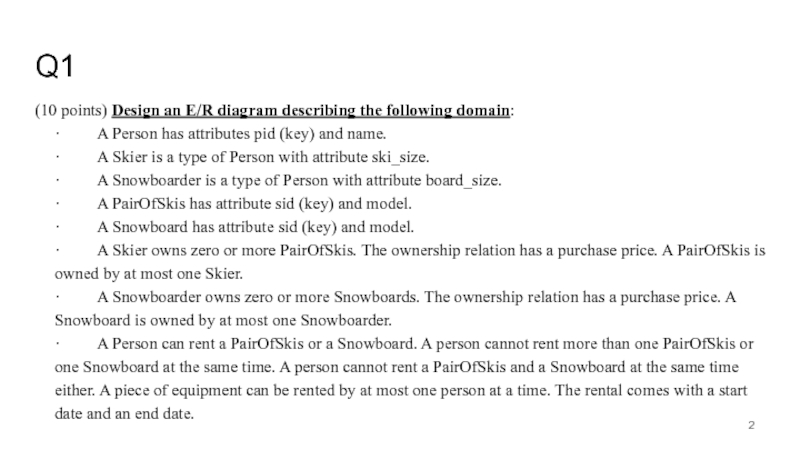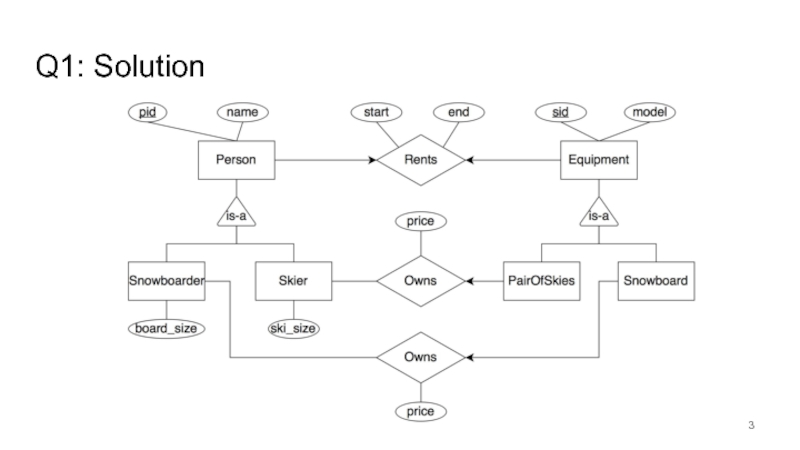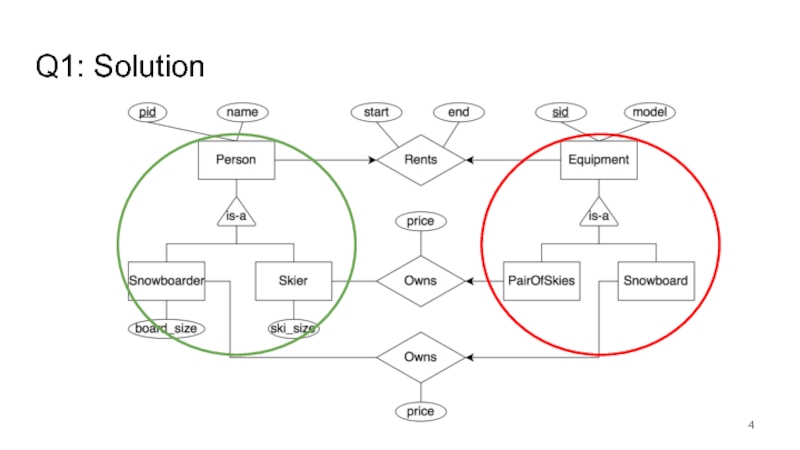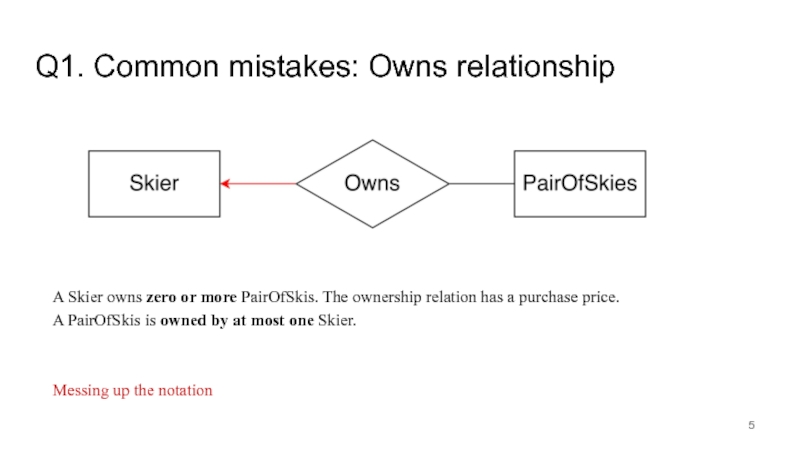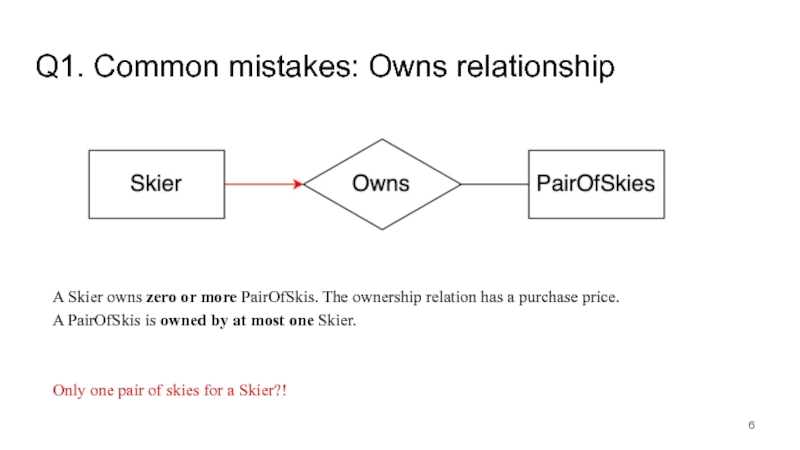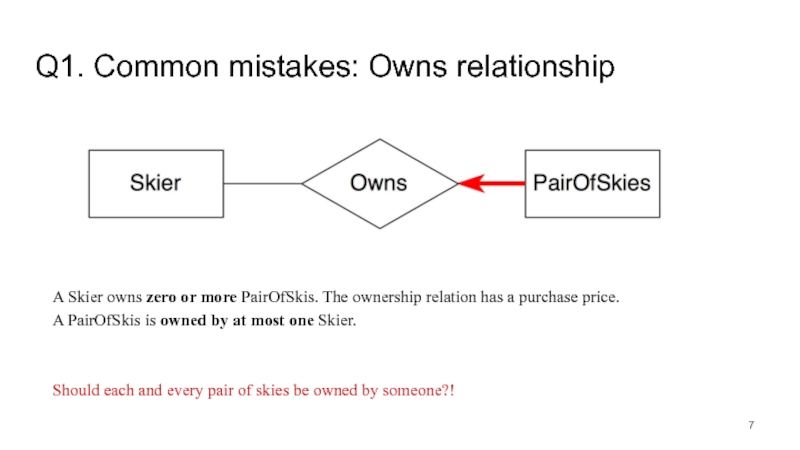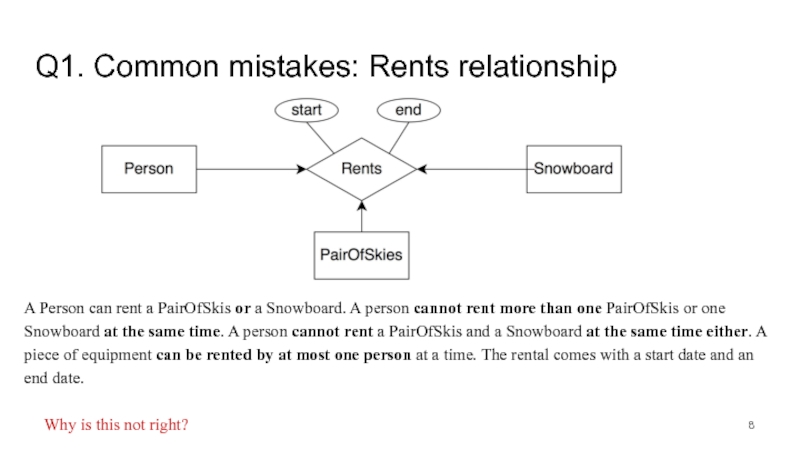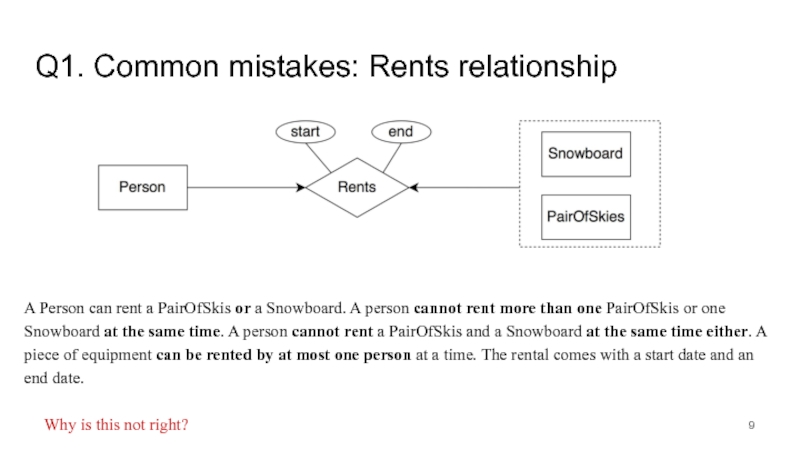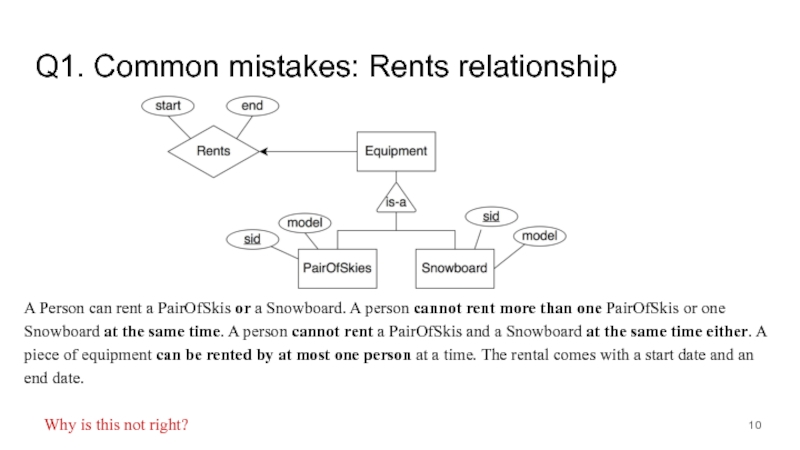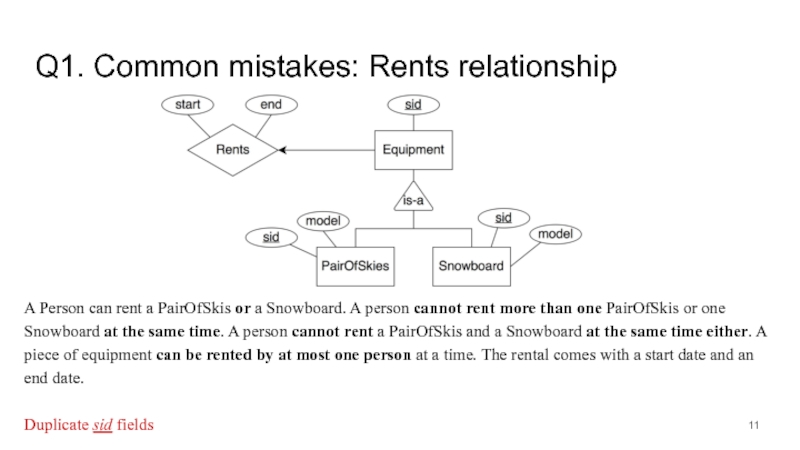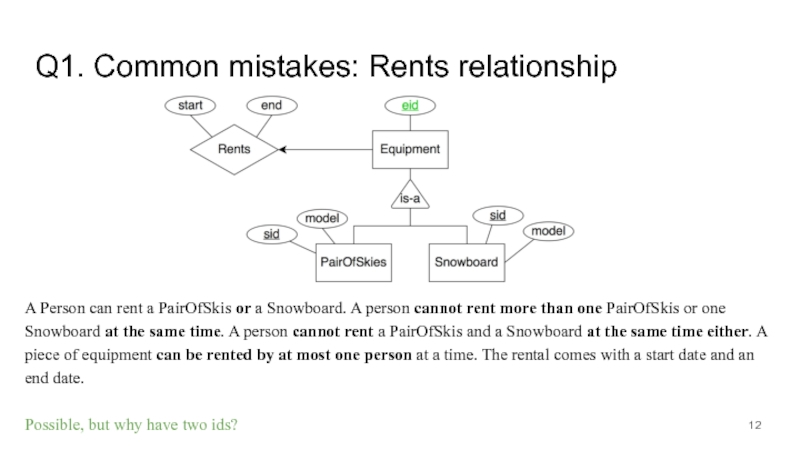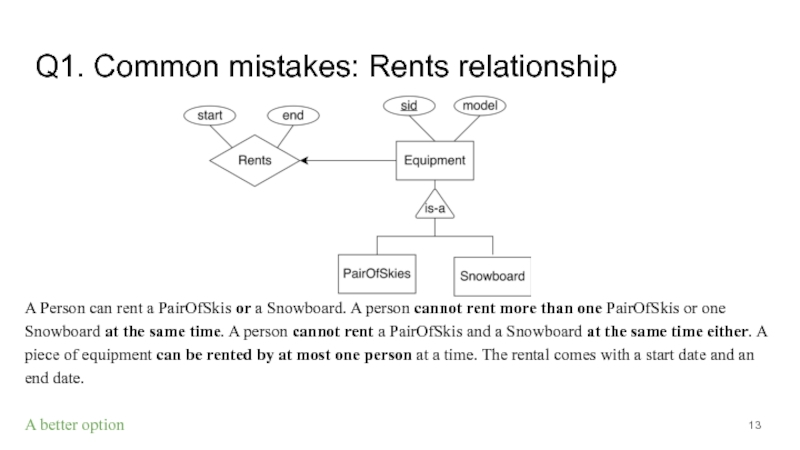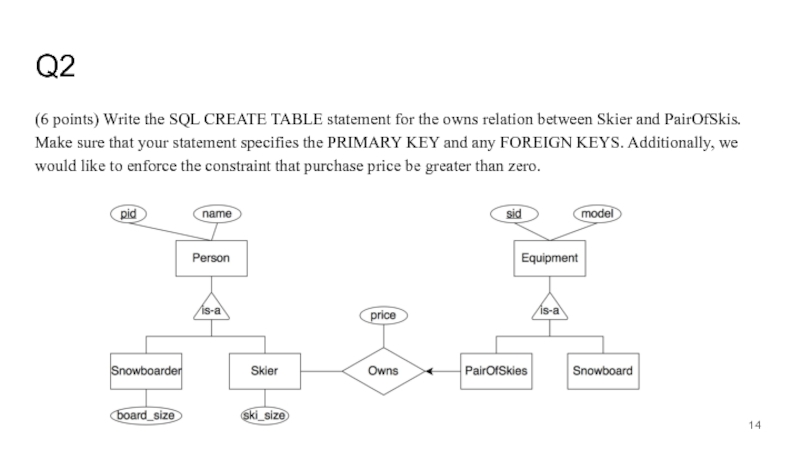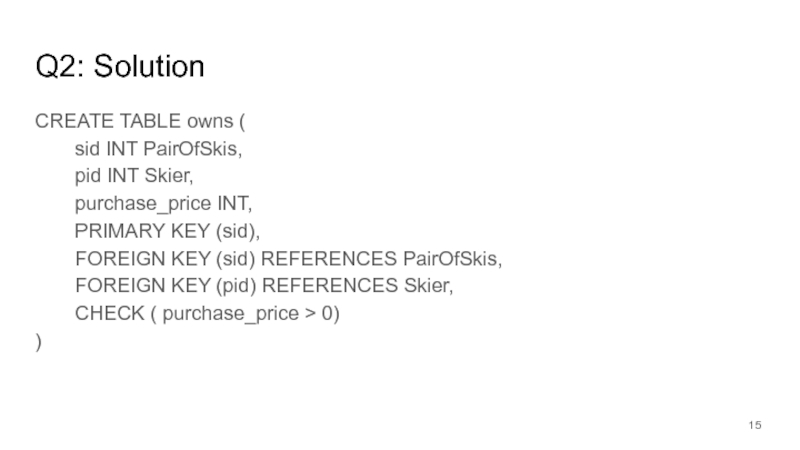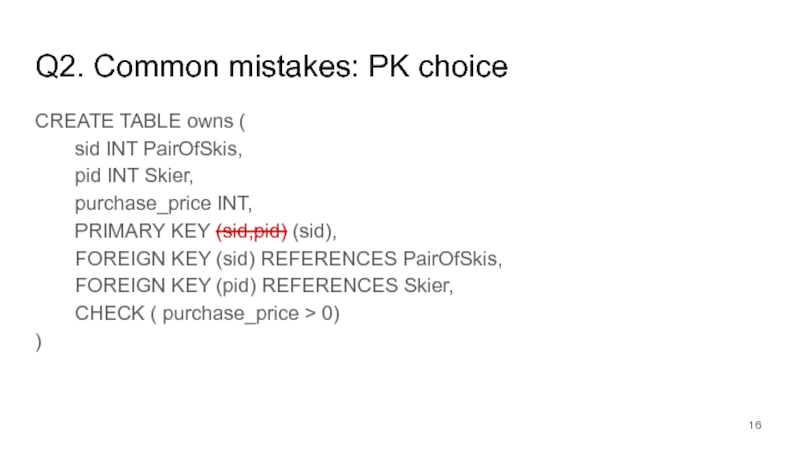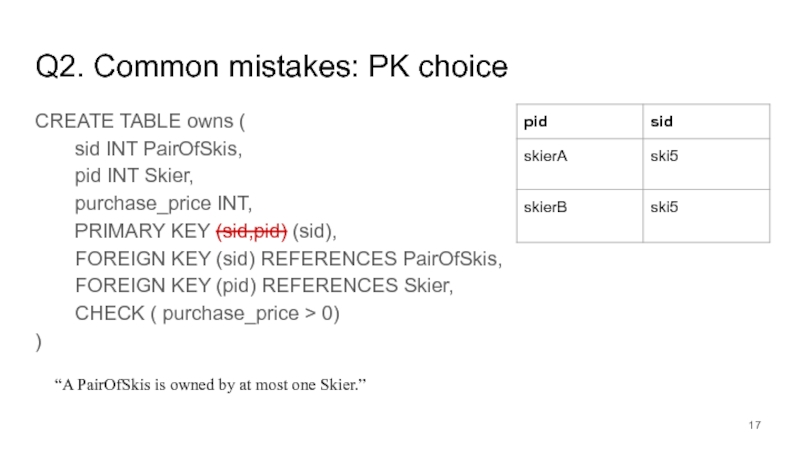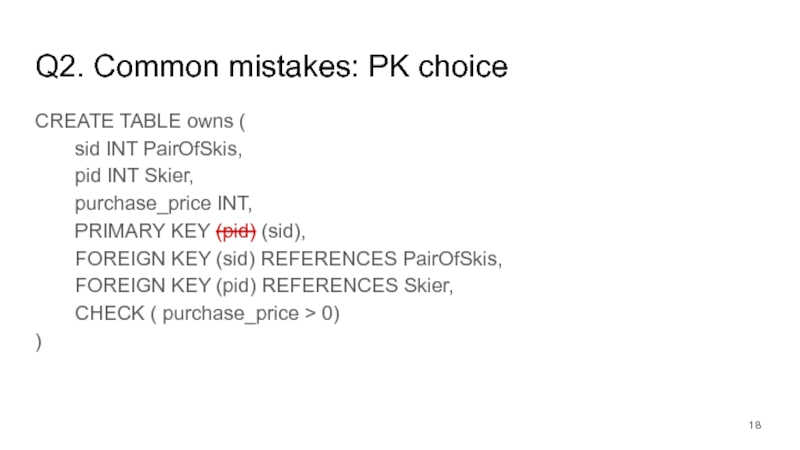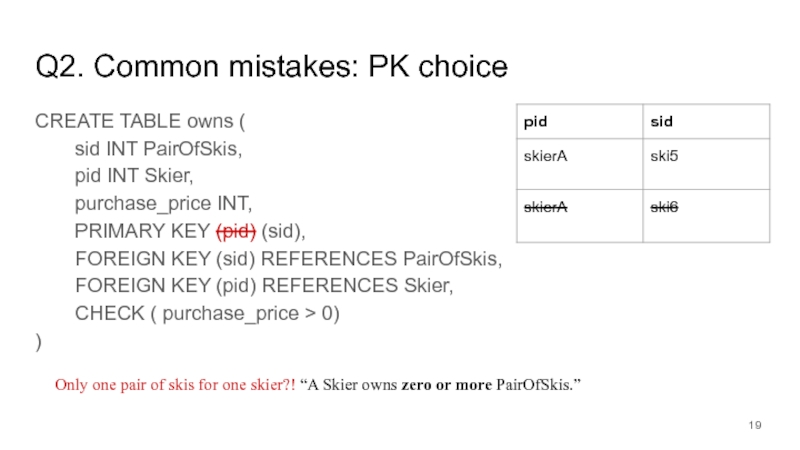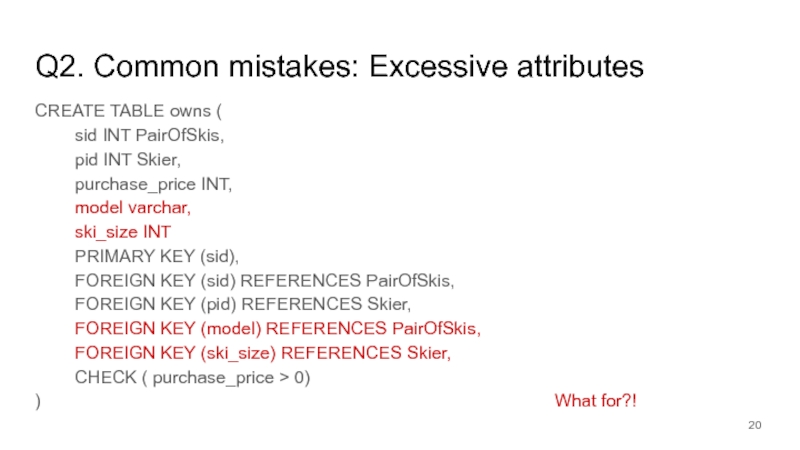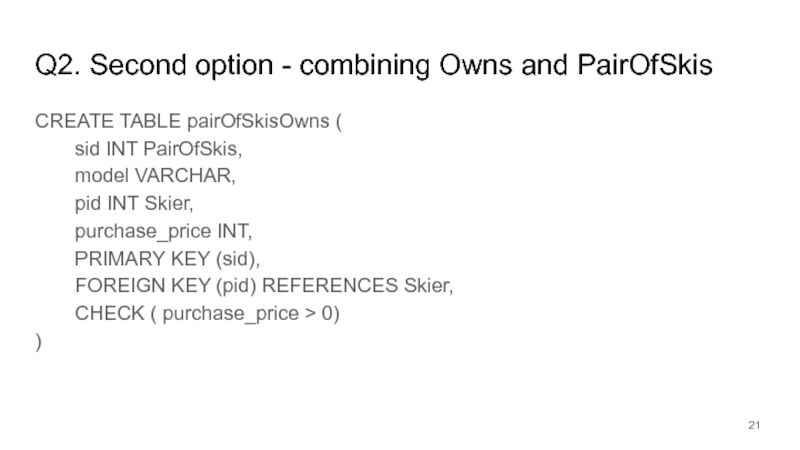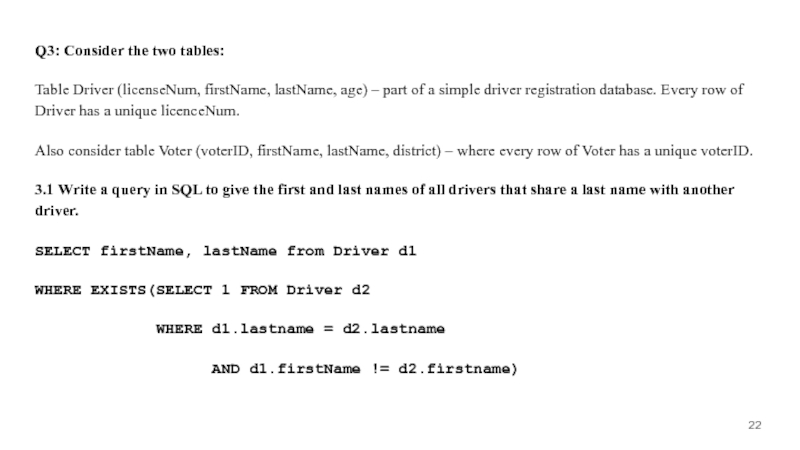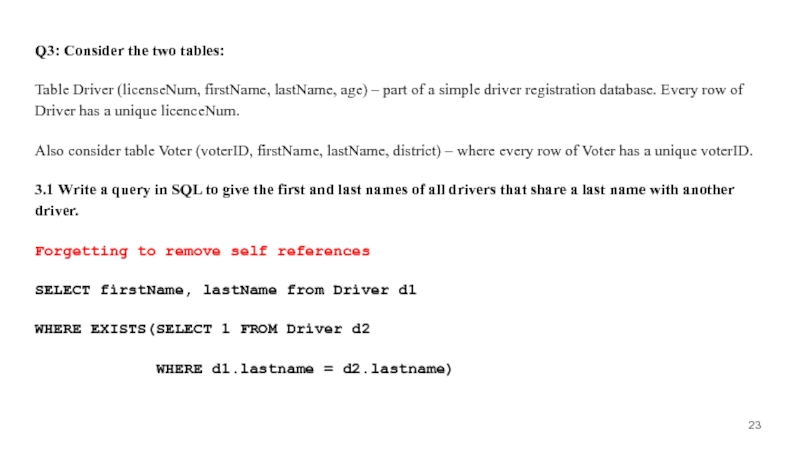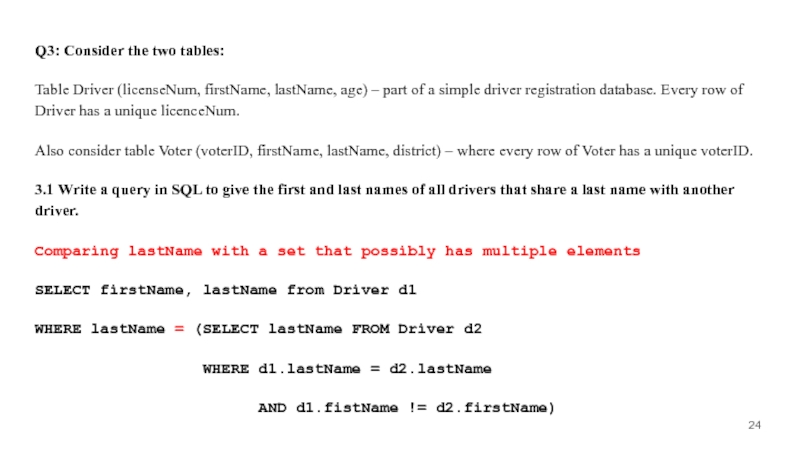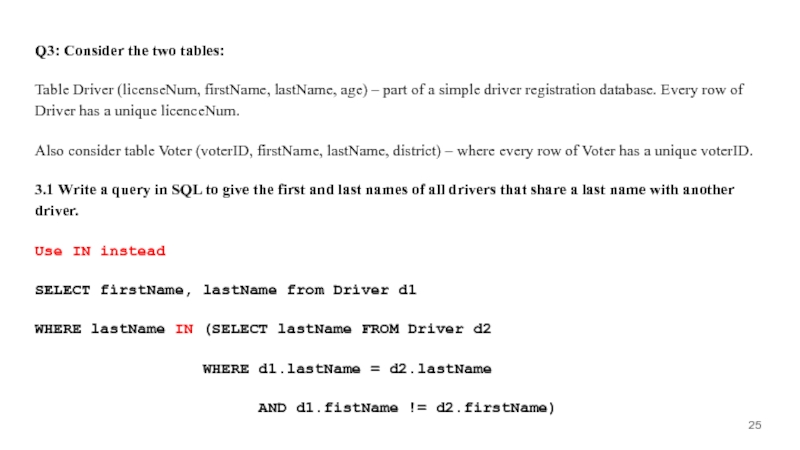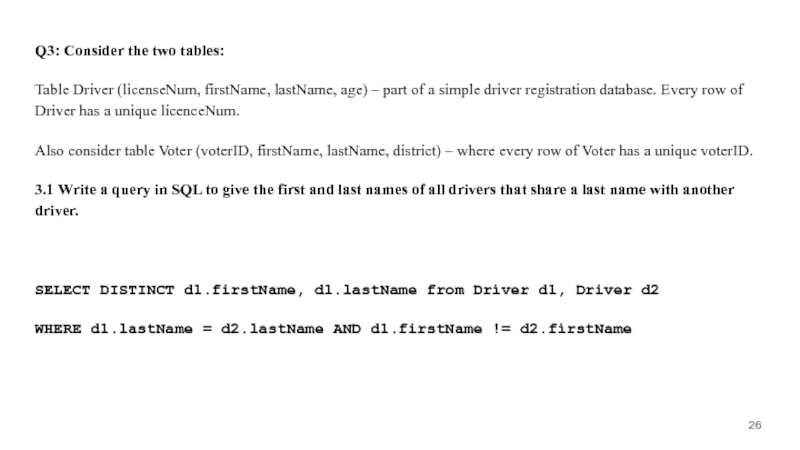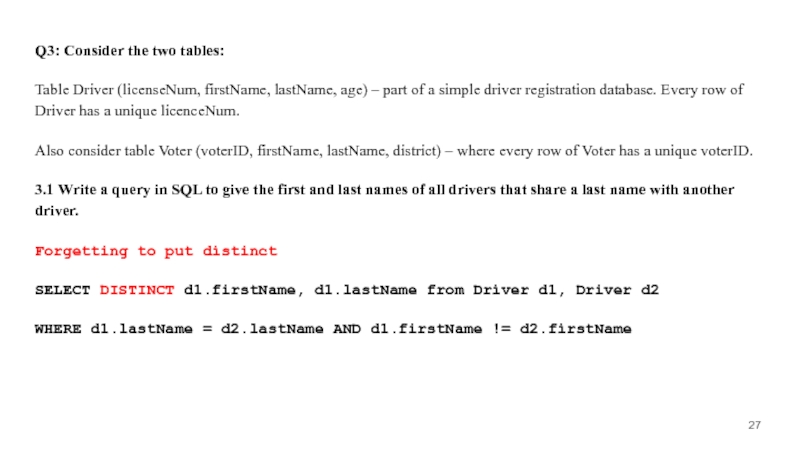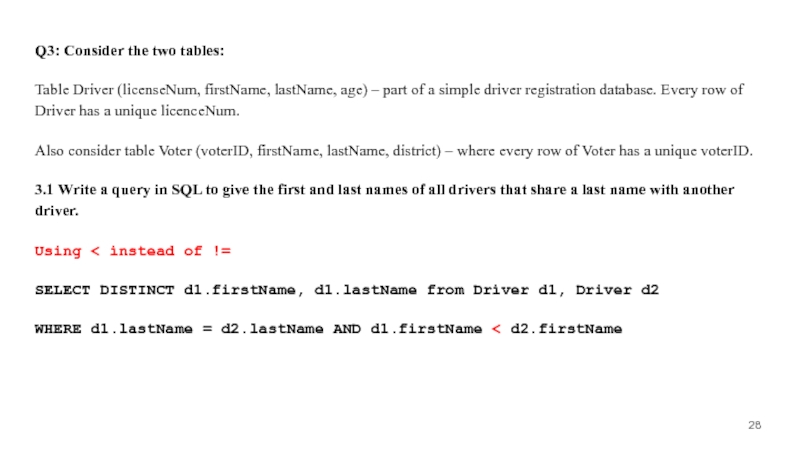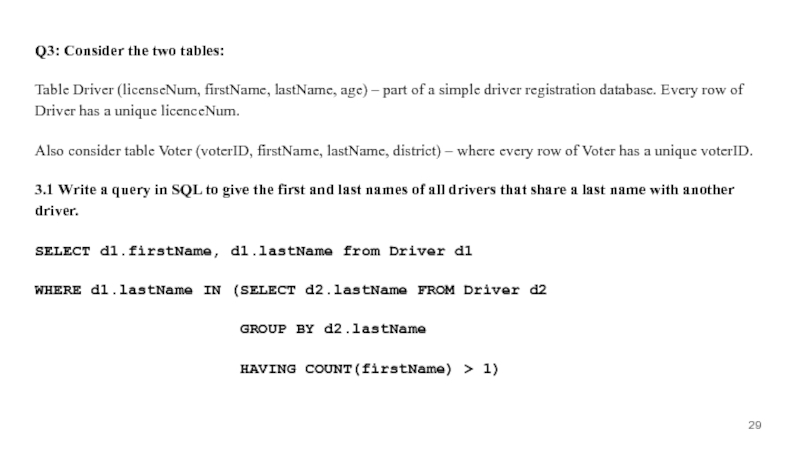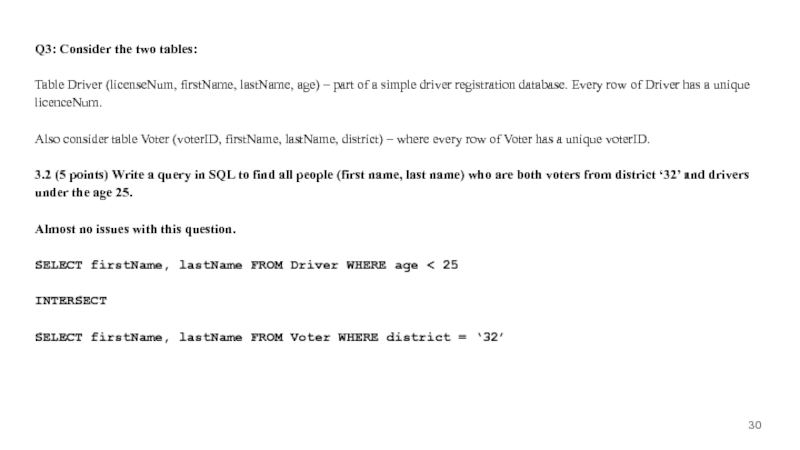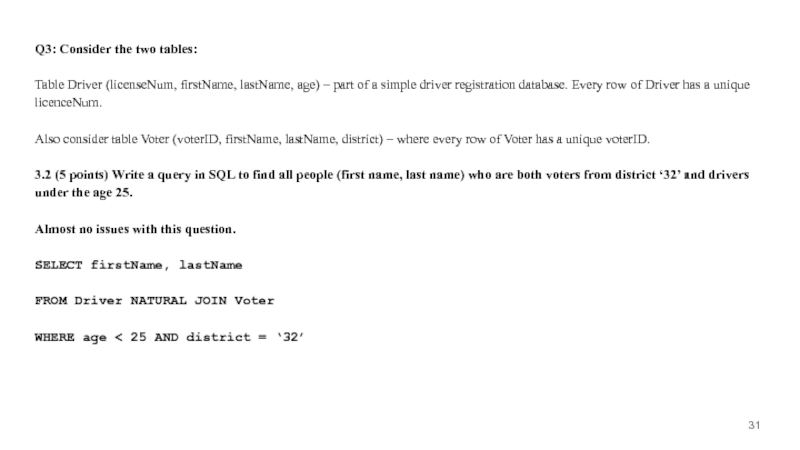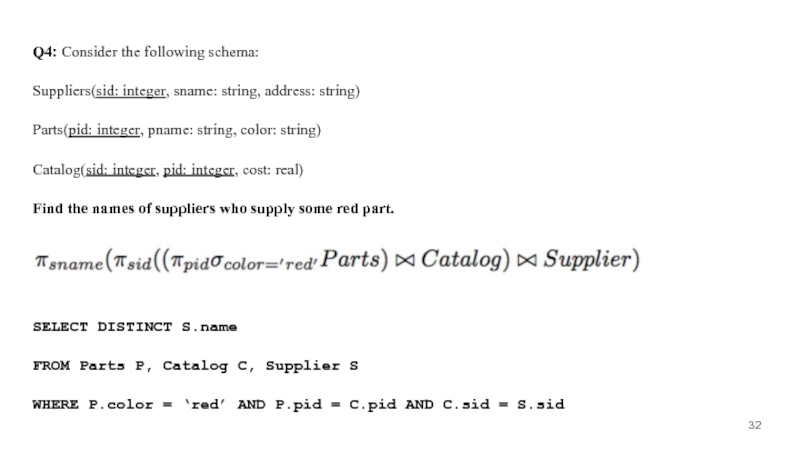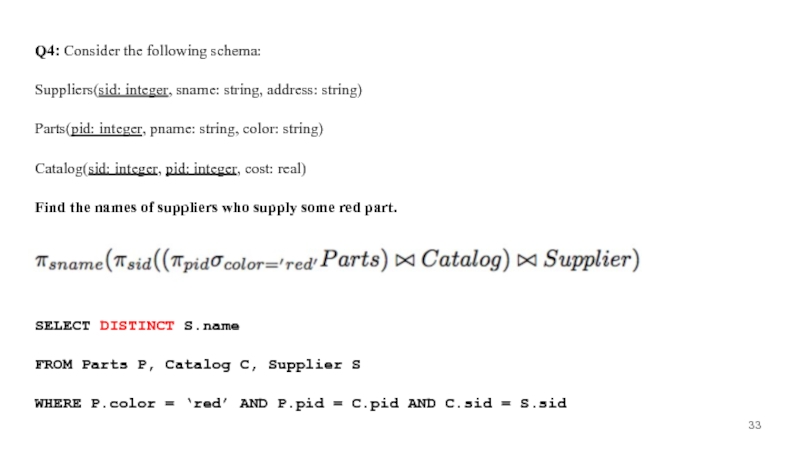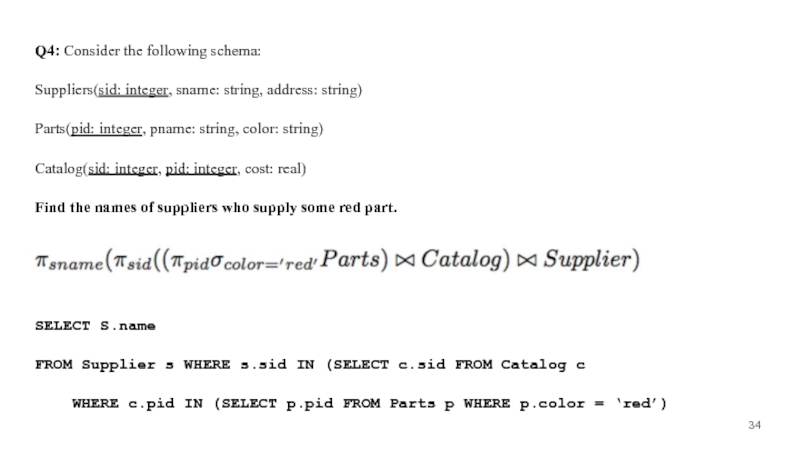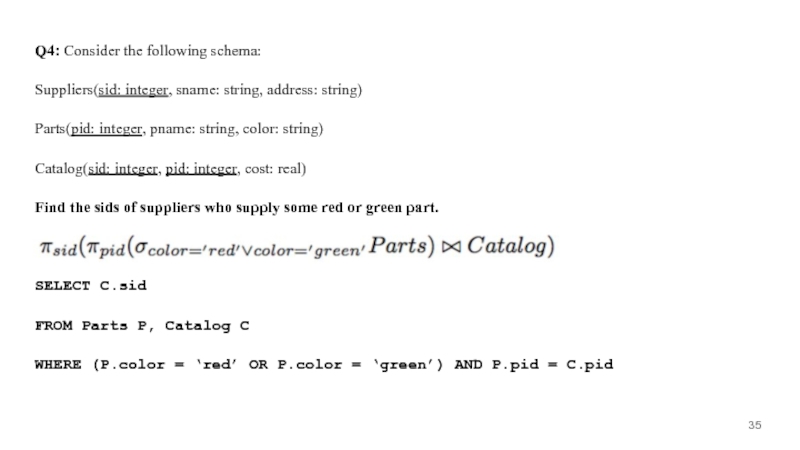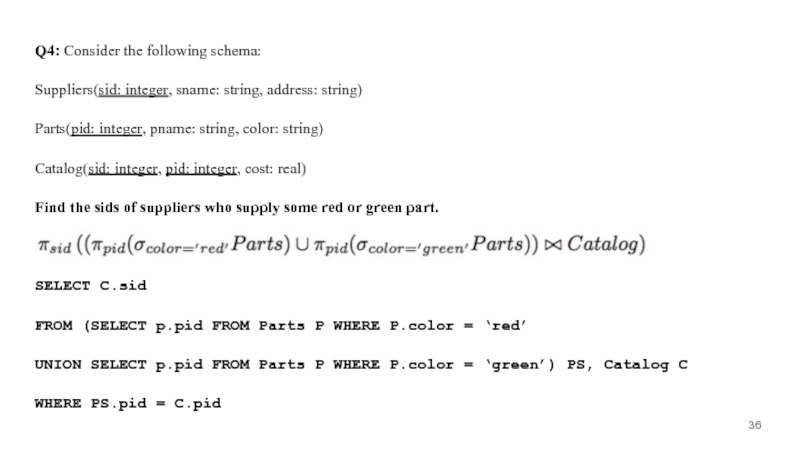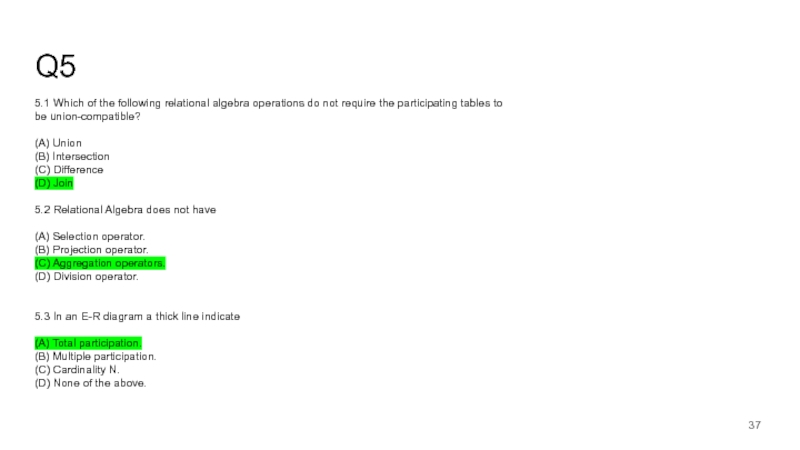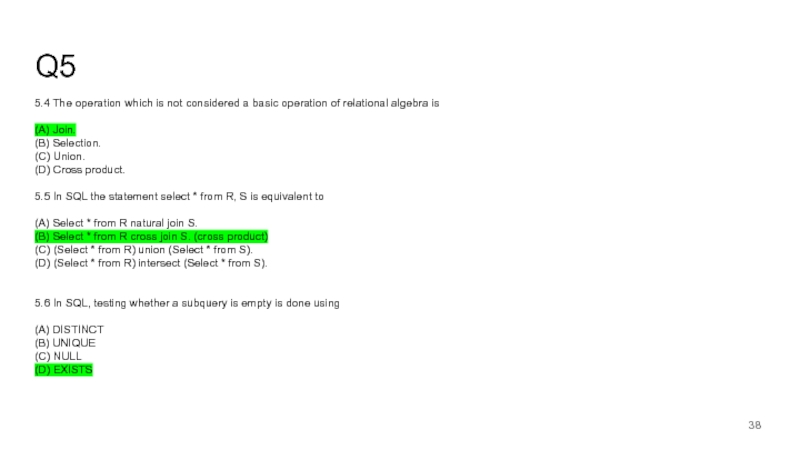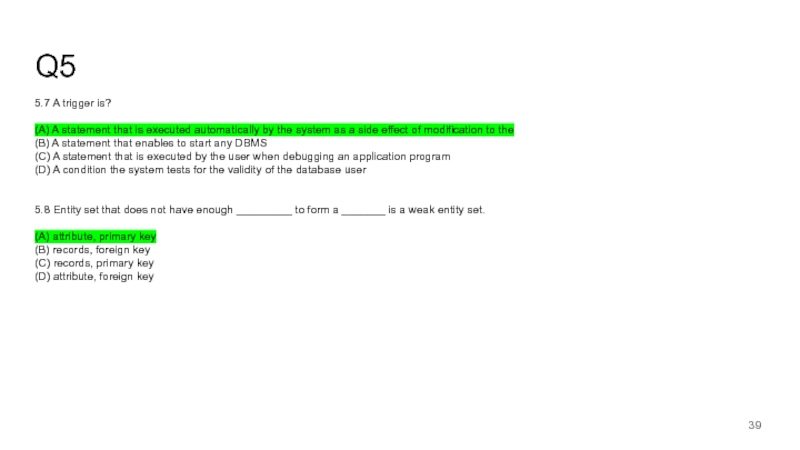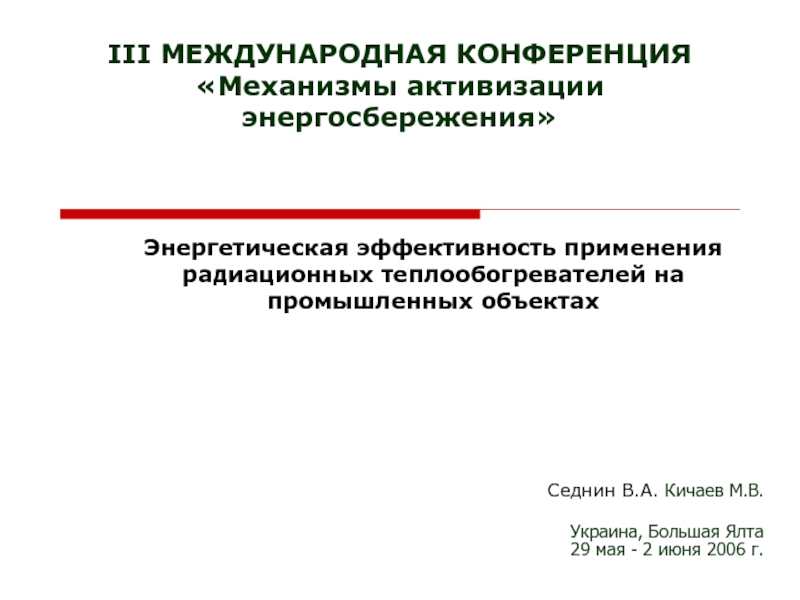- Главная
- Разное
- Дизайн
- Бизнес и предпринимательство
- Аналитика
- Образование
- Развлечения
- Красота и здоровье
- Финансы
- Государство
- Путешествия
- Спорт
- Недвижимость
- Армия
- Графика
- Культурология
- Еда и кулинария
- Лингвистика
- Английский язык
- Астрономия
- Алгебра
- Биология
- География
- Детские презентации
- Информатика
- История
- Литература
- Маркетинг
- Математика
- Медицина
- Менеджмент
- Музыка
- МХК
- Немецкий язык
- ОБЖ
- Обществознание
- Окружающий мир
- Педагогика
- Русский язык
- Технология
- Физика
- Философия
- Химия
- Шаблоны, картинки для презентаций
- Экология
- Экономика
- Юриспруденция
Data Modeling and Databases презентация
Содержание
- 1. Data Modeling and Databases
- 2. Q1 (10 points) Design an E/R diagram
- 3. Q1: Solution
- 4. Q1: Solution
- 5. Q1. Common mistakes: Owns relationship A Skier
- 6. Q1. Common mistakes: Owns relationship A Skier
- 7. Q1. Common mistakes: Owns relationship A Skier
- 8. Q1. Common mistakes: Rents relationship A Person
- 9. Q1. Common mistakes: Rents relationship A Person
- 10. Q1. Common mistakes: Rents relationship A Person
- 11. Q1. Common mistakes: Rents relationship A Person
- 12. Q1. Common mistakes: Rents relationship A Person
- 13. Q1. Common mistakes: Rents relationship A Person
- 14. Q2 (6 points) Write the SQL CREATE
- 15. Q2: Solution CREATE TABLE owns ( sid
- 16. Q2. Common mistakes: PK choice CREATE
- 17. Q2. Common mistakes: PK choice CREATE
- 18. Q2. Common mistakes: PK choice CREATE
- 19. Q2. Common mistakes: PK choice CREATE
- 20. Q2. Common mistakes: Excessive attributes CREATE
- 21. Q2. Second option - combining Owns and
- 22. Q3: Consider the two tables: Table Driver
- 23. Q3: Consider the two tables: Table Driver
- 24. Q3: Consider the two tables: Table Driver
- 25. Q3: Consider the two tables: Table Driver
- 26. Q3: Consider the two tables: Table Driver
- 27. Q3: Consider the two tables: Table Driver
- 28. Q3: Consider the two tables: Table Driver
- 29. Q3: Consider the two tables: Table Driver
- 30. Q3: Consider the two tables: Table Driver
- 31. Q3: Consider the two tables: Table Driver
- 32. Q4: Consider the following schema: Suppliers(sid: integer,
- 33. Q4: Consider the following schema: Suppliers(sid: integer,
- 34. Q4: Consider the following schema: Suppliers(sid: integer,
- 35. Q4: Consider the following schema: Suppliers(sid: integer,
- 36. Q4: Consider the following schema: Suppliers(sid: integer,
- 37. Q5 5.1 Which of the following relational
- 38. Q5 5.4 The operation which is not
- 39. Q5 5.7 A trigger is? (A)
- 40. QA
Q1 (10 points) Design an E/R diagram describing the following domain: · A Person has attributes pid (key) and name. · A Skier
Слайд 1Data Modeling and Databases
Lab 6: Recitation
Bulat Gabbasov, Albina Khusainova
Innopolis University
2016
Слайд 2Q1
(10 points) Design an E/R diagram describing the following domain:
·
A Person has attributes pid (key) and name.
· A Skier is a type of Person with attribute ski_size.
· A Snowboarder is a type of Person with attribute board_size.
· A PairOfSkis has attribute sid (key) and model.
· A Snowboard has attribute sid (key) and model.
· A Skier owns zero or more PairOfSkis. The ownership relation has a purchase price. A PairOfSkis is owned by at most one Skier.
· A Snowboarder owns zero or more Snowboards. The ownership relation has a purchase price. A Snowboard is owned by at most one Snowboarder.
· A Person can rent a PairOfSkis or a Snowboard. A person cannot rent more than one PairOfSkis or one Snowboard at the same time. A person cannot rent a PairOfSkis and a Snowboard at the same time either. A piece of equipment can be rented by at most one person at a time. The rental comes with a start date and an end date.
· A Skier is a type of Person with attribute ski_size.
· A Snowboarder is a type of Person with attribute board_size.
· A PairOfSkis has attribute sid (key) and model.
· A Snowboard has attribute sid (key) and model.
· A Skier owns zero or more PairOfSkis. The ownership relation has a purchase price. A PairOfSkis is owned by at most one Skier.
· A Snowboarder owns zero or more Snowboards. The ownership relation has a purchase price. A Snowboard is owned by at most one Snowboarder.
· A Person can rent a PairOfSkis or a Snowboard. A person cannot rent more than one PairOfSkis or one Snowboard at the same time. A person cannot rent a PairOfSkis and a Snowboard at the same time either. A piece of equipment can be rented by at most one person at a time. The rental comes with a start date and an end date.
Слайд 5Q1. Common mistakes: Owns relationship
A Skier owns zero or more PairOfSkis.
The ownership relation has a purchase price.
A PairOfSkis is owned by at most one Skier.
Messing up the notation
A PairOfSkis is owned by at most one Skier.
Messing up the notation
Слайд 6Q1. Common mistakes: Owns relationship
A Skier owns zero or more PairOfSkis.
The ownership relation has a purchase price.
A PairOfSkis is owned by at most one Skier.
Only one pair of skies for a Skier?!
A PairOfSkis is owned by at most one Skier.
Only one pair of skies for a Skier?!
Слайд 7Q1. Common mistakes: Owns relationship
A Skier owns zero or more PairOfSkis.
The ownership relation has a purchase price.
A PairOfSkis is owned by at most one Skier.
Should each and every pair of skies be owned by someone?!
A PairOfSkis is owned by at most one Skier.
Should each and every pair of skies be owned by someone?!
Слайд 8Q1. Common mistakes: Rents relationship
A Person can rent a PairOfSkis or
a Snowboard. A person cannot rent more than one PairOfSkis or one Snowboard at the same time. A person cannot rent a PairOfSkis and a Snowboard at the same time either. A piece of equipment can be rented by at most one person at a time. The rental comes with a start date and an end date.
Why is this not right?
Why is this not right?
Слайд 9Q1. Common mistakes: Rents relationship
A Person can rent a PairOfSkis or
a Snowboard. A person cannot rent more than one PairOfSkis or one Snowboard at the same time. A person cannot rent a PairOfSkis and a Snowboard at the same time either. A piece of equipment can be rented by at most one person at a time. The rental comes with a start date and an end date.
Why is this not right?
Why is this not right?
Слайд 10Q1. Common mistakes: Rents relationship
A Person can rent a PairOfSkis or
a Snowboard. A person cannot rent more than one PairOfSkis or one Snowboard at the same time. A person cannot rent a PairOfSkis and a Snowboard at the same time either. A piece of equipment can be rented by at most one person at a time. The rental comes with a start date and an end date.
Why is this not right?
Why is this not right?
Слайд 11Q1. Common mistakes: Rents relationship
A Person can rent a PairOfSkis or
a Snowboard. A person cannot rent more than one PairOfSkis or one Snowboard at the same time. A person cannot rent a PairOfSkis and a Snowboard at the same time either. A piece of equipment can be rented by at most one person at a time. The rental comes with a start date and an end date.
Duplicate sid fields
Duplicate sid fields
Слайд 12Q1. Common mistakes: Rents relationship
A Person can rent a PairOfSkis or
a Snowboard. A person cannot rent more than one PairOfSkis or one Snowboard at the same time. A person cannot rent a PairOfSkis and a Snowboard at the same time either. A piece of equipment can be rented by at most one person at a time. The rental comes with a start date and an end date.
Possible, but why have two ids?
Possible, but why have two ids?
Слайд 13Q1. Common mistakes: Rents relationship
A Person can rent a PairOfSkis or
a Snowboard. A person cannot rent more than one PairOfSkis or one Snowboard at the same time. A person cannot rent a PairOfSkis and a Snowboard at the same time either. A piece of equipment can be rented by at most one person at a time. The rental comes with a start date and an end date.
A better option
A better option
Слайд 14Q2
(6 points) Write the SQL CREATE TABLE statement for the owns
relation between Skier and PairOfSkis. Make sure that your statement specifies the PRIMARY KEY and any FOREIGN KEYS. Additionally, we would like to enforce the constraint that purchase price be greater than zero.
Слайд 15Q2: Solution
CREATE TABLE owns (
sid INT PairOfSkis,
pid INT Skier,
purchase_price INT,
PRIMARY KEY (sid),
FOREIGN KEY (sid) REFERENCES PairOfSkis,
FOREIGN KEY (pid) REFERENCES Skier,
CHECK ( purchase_price > 0)
)
Слайд 16Q2. Common mistakes: PK choice
CREATE TABLE owns (
sid INT PairOfSkis,
pid
INT Skier,
purchase_price INT,
PRIMARY KEY (sid,pid) (sid),
FOREIGN KEY (sid) REFERENCES PairOfSkis,
FOREIGN KEY (pid) REFERENCES Skier,
CHECK ( purchase_price > 0)
)
Слайд 17Q2. Common mistakes: PK choice
CREATE TABLE owns (
sid INT PairOfSkis,
pid
INT Skier,
purchase_price INT,
PRIMARY KEY (sid,pid) (sid),
FOREIGN KEY (sid) REFERENCES PairOfSkis,
FOREIGN KEY (pid) REFERENCES Skier,
CHECK ( purchase_price > 0)
)
“A PairOfSkis is owned by at most one Skier.”
“A PairOfSkis is owned by at most one Skier.”
Слайд 18Q2. Common mistakes: PK choice
CREATE TABLE owns (
sid INT PairOfSkis,
pid
INT Skier,
purchase_price INT,
PRIMARY KEY (pid) (sid),
FOREIGN KEY (sid) REFERENCES PairOfSkis,
FOREIGN KEY (pid) REFERENCES Skier,
CHECK ( purchase_price > 0)
)
Слайд 19Q2. Common mistakes: PK choice
CREATE TABLE owns (
sid INT PairOfSkis,
pid
INT Skier,
purchase_price INT,
PRIMARY KEY (pid) (sid),
FOREIGN KEY (sid) REFERENCES PairOfSkis,
FOREIGN KEY (pid) REFERENCES Skier,
CHECK ( purchase_price > 0)
)
Only one pair of skis for one skier?! “A Skier owns zero or more PairOfSkis.”
Only one pair of skis for one skier?! “A Skier owns zero or more PairOfSkis.”
Слайд 20Q2. Common mistakes: Excessive attributes
CREATE TABLE owns (
sid INT PairOfSkis,
pid
INT Skier,
purchase_price INT,
model varchar,
ski_size INT
PRIMARY KEY (sid),
FOREIGN KEY (sid) REFERENCES PairOfSkis,
FOREIGN KEY (pid) REFERENCES Skier,
FOREIGN KEY (model) REFERENCES PairOfSkis,
FOREIGN KEY (ski_size) REFERENCES Skier,
CHECK ( purchase_price > 0)
) What for?!
Слайд 21Q2. Second option - combining Owns and PairOfSkis
CREATE TABLE pairOfSkisOwns
(
sid INT PairOfSkis,
model VARCHAR,
pid INT Skier,
purchase_price INT,
PRIMARY KEY (sid),
FOREIGN KEY (pid) REFERENCES Skier,
CHECK ( purchase_price > 0)
)
Слайд 22Q3: Consider the two tables:
Table Driver (licenseNum, firstName, lastName, age) –
part of a simple driver registration database. Every row of Driver has a unique licenceNum.
Also consider table Voter (voterID, firstName, lastName, district) – where every row of Voter has a unique voterID.
3.1 Write a query in SQL to give the first and last names of all drivers that share a last name with another driver.
SELECT firstName, lastName from Driver d1
WHERE EXISTS(SELECT 1 FROM Driver d2
WHERE d1.lastname = d2.lastname
AND d1.firstName != d2.firstname)
Also consider table Voter (voterID, firstName, lastName, district) – where every row of Voter has a unique voterID.
3.1 Write a query in SQL to give the first and last names of all drivers that share a last name with another driver.
SELECT firstName, lastName from Driver d1
WHERE EXISTS(SELECT 1 FROM Driver d2
WHERE d1.lastname = d2.lastname
AND d1.firstName != d2.firstname)
Слайд 23Q3: Consider the two tables:
Table Driver (licenseNum, firstName, lastName, age) –
part of a simple driver registration database. Every row of Driver has a unique licenceNum.
Also consider table Voter (voterID, firstName, lastName, district) – where every row of Voter has a unique voterID.
3.1 Write a query in SQL to give the first and last names of all drivers that share a last name with another driver.
Forgetting to remove self references
SELECT firstName, lastName from Driver d1
WHERE EXISTS(SELECT 1 FROM Driver d2
WHERE d1.lastname = d2.lastname)
Also consider table Voter (voterID, firstName, lastName, district) – where every row of Voter has a unique voterID.
3.1 Write a query in SQL to give the first and last names of all drivers that share a last name with another driver.
Forgetting to remove self references
SELECT firstName, lastName from Driver d1
WHERE EXISTS(SELECT 1 FROM Driver d2
WHERE d1.lastname = d2.lastname)
Слайд 24Q3: Consider the two tables:
Table Driver (licenseNum, firstName, lastName, age) –
part of a simple driver registration database. Every row of Driver has a unique licenceNum.
Also consider table Voter (voterID, firstName, lastName, district) – where every row of Voter has a unique voterID.
3.1 Write a query in SQL to give the first and last names of all drivers that share a last name with another driver.
Comparing lastName with a set that possibly has multiple elements
SELECT firstName, lastName from Driver d1
WHERE lastName = (SELECT lastName FROM Driver d2
WHERE d1.lastName = d2.lastName
AND d1.fistName != d2.firstName)
Also consider table Voter (voterID, firstName, lastName, district) – where every row of Voter has a unique voterID.
3.1 Write a query in SQL to give the first and last names of all drivers that share a last name with another driver.
Comparing lastName with a set that possibly has multiple elements
SELECT firstName, lastName from Driver d1
WHERE lastName = (SELECT lastName FROM Driver d2
WHERE d1.lastName = d2.lastName
AND d1.fistName != d2.firstName)
Слайд 25Q3: Consider the two tables:
Table Driver (licenseNum, firstName, lastName, age) –
part of a simple driver registration database. Every row of Driver has a unique licenceNum.
Also consider table Voter (voterID, firstName, lastName, district) – where every row of Voter has a unique voterID.
3.1 Write a query in SQL to give the first and last names of all drivers that share a last name with another driver.
Use IN instead
SELECT firstName, lastName from Driver d1
WHERE lastName IN (SELECT lastName FROM Driver d2
WHERE d1.lastName = d2.lastName
AND d1.fistName != d2.firstName)
Also consider table Voter (voterID, firstName, lastName, district) – where every row of Voter has a unique voterID.
3.1 Write a query in SQL to give the first and last names of all drivers that share a last name with another driver.
Use IN instead
SELECT firstName, lastName from Driver d1
WHERE lastName IN (SELECT lastName FROM Driver d2
WHERE d1.lastName = d2.lastName
AND d1.fistName != d2.firstName)
Слайд 26Q3: Consider the two tables:
Table Driver (licenseNum, firstName, lastName, age) –
part of a simple driver registration database. Every row of Driver has a unique licenceNum.
Also consider table Voter (voterID, firstName, lastName, district) – where every row of Voter has a unique voterID.
3.1 Write a query in SQL to give the first and last names of all drivers that share a last name with another driver.
SELECT DISTINCT d1.firstName, d1.lastName from Driver d1, Driver d2
WHERE d1.lastName = d2.lastName AND d1.firstName != d2.firstName
Also consider table Voter (voterID, firstName, lastName, district) – where every row of Voter has a unique voterID.
3.1 Write a query in SQL to give the first and last names of all drivers that share a last name with another driver.
SELECT DISTINCT d1.firstName, d1.lastName from Driver d1, Driver d2
WHERE d1.lastName = d2.lastName AND d1.firstName != d2.firstName
Слайд 27Q3: Consider the two tables:
Table Driver (licenseNum, firstName, lastName, age) –
part of a simple driver registration database. Every row of Driver has a unique licenceNum.
Also consider table Voter (voterID, firstName, lastName, district) – where every row of Voter has a unique voterID.
3.1 Write a query in SQL to give the first and last names of all drivers that share a last name with another driver.
Forgetting to put distinct
SELECT DISTINCT d1.firstName, d1.lastName from Driver d1, Driver d2
WHERE d1.lastName = d2.lastName AND d1.firstName != d2.firstName
Also consider table Voter (voterID, firstName, lastName, district) – where every row of Voter has a unique voterID.
3.1 Write a query in SQL to give the first and last names of all drivers that share a last name with another driver.
Forgetting to put distinct
SELECT DISTINCT d1.firstName, d1.lastName from Driver d1, Driver d2
WHERE d1.lastName = d2.lastName AND d1.firstName != d2.firstName
Слайд 28Q3: Consider the two tables:
Table Driver (licenseNum, firstName, lastName, age) –
part of a simple driver registration database. Every row of Driver has a unique licenceNum.
Also consider table Voter (voterID, firstName, lastName, district) – where every row of Voter has a unique voterID.
3.1 Write a query in SQL to give the first and last names of all drivers that share a last name with another driver.
Using < instead of !=
SELECT DISTINCT d1.firstName, d1.lastName from Driver d1, Driver d2
WHERE d1.lastName = d2.lastName AND d1.firstName < d2.firstName
Also consider table Voter (voterID, firstName, lastName, district) – where every row of Voter has a unique voterID.
3.1 Write a query in SQL to give the first and last names of all drivers that share a last name with another driver.
Using < instead of !=
SELECT DISTINCT d1.firstName, d1.lastName from Driver d1, Driver d2
WHERE d1.lastName = d2.lastName AND d1.firstName < d2.firstName
Слайд 29Q3: Consider the two tables:
Table Driver (licenseNum, firstName, lastName, age) –
part of a simple driver registration database. Every row of Driver has a unique licenceNum.
Also consider table Voter (voterID, firstName, lastName, district) – where every row of Voter has a unique voterID.
3.1 Write a query in SQL to give the first and last names of all drivers that share a last name with another driver.
SELECT d1.firstName, d1.lastName from Driver d1
WHERE d1.lastName IN (SELECT d2.lastName FROM Driver d2
GROUP BY d2.lastName
HAVING COUNT(firstName) > 1)
Also consider table Voter (voterID, firstName, lastName, district) – where every row of Voter has a unique voterID.
3.1 Write a query in SQL to give the first and last names of all drivers that share a last name with another driver.
SELECT d1.firstName, d1.lastName from Driver d1
WHERE d1.lastName IN (SELECT d2.lastName FROM Driver d2
GROUP BY d2.lastName
HAVING COUNT(firstName) > 1)
Слайд 30Q3: Consider the two tables:
Table Driver (licenseNum, firstName, lastName, age) –
part of a simple driver registration database. Every row of Driver has a unique licenceNum.
Also consider table Voter (voterID, firstName, lastName, district) – where every row of Voter has a unique voterID.
3.2 (5 points) Write a query in SQL to find all people (first name, last name) who are both voters from district ‘32’ and drivers under the age 25.
Almost no issues with this question.
SELECT firstName, lastName FROM Driver WHERE age < 25
INTERSECT
SELECT firstName, lastName FROM Voter WHERE district = ‘32’
Also consider table Voter (voterID, firstName, lastName, district) – where every row of Voter has a unique voterID.
3.2 (5 points) Write a query in SQL to find all people (first name, last name) who are both voters from district ‘32’ and drivers under the age 25.
Almost no issues with this question.
SELECT firstName, lastName FROM Driver WHERE age < 25
INTERSECT
SELECT firstName, lastName FROM Voter WHERE district = ‘32’
Слайд 31Q3: Consider the two tables:
Table Driver (licenseNum, firstName, lastName, age) –
part of a simple driver registration database. Every row of Driver has a unique licenceNum.
Also consider table Voter (voterID, firstName, lastName, district) – where every row of Voter has a unique voterID.
3.2 (5 points) Write a query in SQL to find all people (first name, last name) who are both voters from district ‘32’ and drivers under the age 25.
Almost no issues with this question.
SELECT firstName, lastName
FROM Driver NATURAL JOIN Voter
WHERE age < 25 AND district = ‘32’
Also consider table Voter (voterID, firstName, lastName, district) – where every row of Voter has a unique voterID.
3.2 (5 points) Write a query in SQL to find all people (first name, last name) who are both voters from district ‘32’ and drivers under the age 25.
Almost no issues with this question.
SELECT firstName, lastName
FROM Driver NATURAL JOIN Voter
WHERE age < 25 AND district = ‘32’
Слайд 32Q4: Consider the following schema:
Suppliers(sid: integer, sname: string, address: string)
Parts(pid: integer,
pname: string, color: string)
Catalog(sid: integer, pid: integer, cost: real)
Find the names of suppliers who supply some red part.
SELECT DISTINCT S.name
FROM Parts P, Catalog C, Supplier S
WHERE P.color = ‘red’ AND P.pid = C.pid AND C.sid = S.sid
Catalog(sid: integer, pid: integer, cost: real)
Find the names of suppliers who supply some red part.
SELECT DISTINCT S.name
FROM Parts P, Catalog C, Supplier S
WHERE P.color = ‘red’ AND P.pid = C.pid AND C.sid = S.sid
Слайд 33Q4: Consider the following schema:
Suppliers(sid: integer, sname: string, address: string)
Parts(pid: integer,
pname: string, color: string)
Catalog(sid: integer, pid: integer, cost: real)
Find the names of suppliers who supply some red part.
SELECT DISTINCT S.name
FROM Parts P, Catalog C, Supplier S
WHERE P.color = ‘red’ AND P.pid = C.pid AND C.sid = S.sid
Catalog(sid: integer, pid: integer, cost: real)
Find the names of suppliers who supply some red part.
SELECT DISTINCT S.name
FROM Parts P, Catalog C, Supplier S
WHERE P.color = ‘red’ AND P.pid = C.pid AND C.sid = S.sid
Слайд 34Q4: Consider the following schema:
Suppliers(sid: integer, sname: string, address: string)
Parts(pid: integer,
pname: string, color: string)
Catalog(sid: integer, pid: integer, cost: real)
Find the names of suppliers who supply some red part.
SELECT S.name
FROM Supplier s WHERE s.sid IN (SELECT c.sid FROM Catalog c
WHERE c.pid IN (SELECT p.pid FROM Parts p WHERE p.color = ‘red’)
Catalog(sid: integer, pid: integer, cost: real)
Find the names of suppliers who supply some red part.
SELECT S.name
FROM Supplier s WHERE s.sid IN (SELECT c.sid FROM Catalog c
WHERE c.pid IN (SELECT p.pid FROM Parts p WHERE p.color = ‘red’)
Слайд 35Q4: Consider the following schema:
Suppliers(sid: integer, sname: string, address: string)
Parts(pid: integer,
pname: string, color: string)
Catalog(sid: integer, pid: integer, cost: real)
Find the sids of suppliers who supply some red or green part.
SELECT C.sid
FROM Parts P, Catalog C
WHERE (P.color = ‘red’ OR P.color = ‘green’) AND P.pid = C.pid
Catalog(sid: integer, pid: integer, cost: real)
Find the sids of suppliers who supply some red or green part.
SELECT C.sid
FROM Parts P, Catalog C
WHERE (P.color = ‘red’ OR P.color = ‘green’) AND P.pid = C.pid
Слайд 36Q4: Consider the following schema:
Suppliers(sid: integer, sname: string, address: string)
Parts(pid: integer,
pname: string, color: string)
Catalog(sid: integer, pid: integer, cost: real)
Find the sids of suppliers who supply some red or green part.
SELECT C.sid
FROM (SELECT p.pid FROM Parts P WHERE P.color = ‘red’
UNION SELECT p.pid FROM Parts P WHERE P.color = ‘green’) PS, Catalog C
WHERE PS.pid = C.pid
Catalog(sid: integer, pid: integer, cost: real)
Find the sids of suppliers who supply some red or green part.
SELECT C.sid
FROM (SELECT p.pid FROM Parts P WHERE P.color = ‘red’
UNION SELECT p.pid FROM Parts P WHERE P.color = ‘green’) PS, Catalog C
WHERE PS.pid = C.pid
Слайд 37Q5
5.1 Which of the following relational algebra operations do not require
the participating tables to
be union-compatible?
(A) Union
(B) Intersection
(C) Difference
(D) Join
5.2 Relational Algebra does not have
(A) Selection operator.
(B) Projection operator.
(C) Aggregation operators.
(D) Division operator.
5.3 In an E-R diagram a thick line indicate
(A) Total participation.
(B) Multiple participation.
(C) Cardinality N.
(D) None of the above.
be union-compatible?
(A) Union
(B) Intersection
(C) Difference
(D) Join
5.2 Relational Algebra does not have
(A) Selection operator.
(B) Projection operator.
(C) Aggregation operators.
(D) Division operator.
5.3 In an E-R diagram a thick line indicate
(A) Total participation.
(B) Multiple participation.
(C) Cardinality N.
(D) None of the above.
Слайд 38Q5
5.4 The operation which is not considered a basic operation of
relational algebra is
(A) Join.
(B) Selection.
(C) Union.
(D) Cross product.
5.5 In SQL the statement select * from R, S is equivalent to
(A) Select * from R natural join S.
(B) Select * from R cross join S. (cross product)
(C) (Select * from R) union (Select * from S).
(D) (Select * from R) intersect (Select * from S).
5.6 In SQL, testing whether a subquery is empty is done using
(A) DISTINCT
(B) UNIQUE
(C) NULL
(D) EXISTS
(A) Join.
(B) Selection.
(C) Union.
(D) Cross product.
5.5 In SQL the statement select * from R, S is equivalent to
(A) Select * from R natural join S.
(B) Select * from R cross join S. (cross product)
(C) (Select * from R) union (Select * from S).
(D) (Select * from R) intersect (Select * from S).
5.6 In SQL, testing whether a subquery is empty is done using
(A) DISTINCT
(B) UNIQUE
(C) NULL
(D) EXISTS
Слайд 39Q5
5.7 A trigger is?
(A) A statement that is executed automatically by
the system as a side effect of modification to the
(B) A statement that enables to start any DBMS
(C) A statement that is executed by the user when debugging an application program
(D) A condition the system tests for the validity of the database user
5.8 Entity set that does not have enough _________ to form a _______ is a weak entity set.
(A) attribute, primary key
(B) records, foreign key
(C) records, primary key
(D) attribute, foreign key
(B) A statement that enables to start any DBMS
(C) A statement that is executed by the user when debugging an application program
(D) A condition the system tests for the validity of the database user
5.8 Entity set that does not have enough _________ to form a _______ is a weak entity set.
(A) attribute, primary key
(B) records, foreign key
(C) records, primary key
(D) attribute, foreign key
